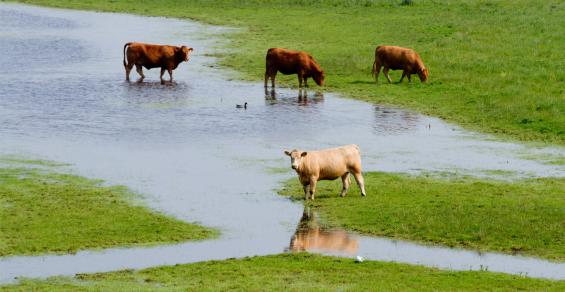Late snowfall and recent rains have led to flooding in some areas of the Northern Plains. Many producers are welcoming this moisture after 2021’s dry weather; however, floodwaters could increase the risk of exposure to anthrax spores for livestock.
Erosion that occurs with flooding increases the chance that animals will ingest the spores of anthrax, warns Gerald Stokka, a veterinarian with North Dakota State University Extension.
Keeping cattle safe
Anthrax is a disease in cattle, humans and other species caused by a bacteria known as Bacillus anthracis. This bacteria has a special survival mechanism called “spore formation.” This characteristic allows the bacteria to produce very hardy spores with a high survival rate.
The spores can survive for years under the right conditions. When these spores come into contact with susceptible animals, the spores can “hatch” and infect livestock such as cattle, resulting in disease and death.
Often, the only initial signs of anthrax infection are finding dead cattle. Cattle can die without signs of illness for a number of reasons, including lightning strikes, clostridial infections and toxicities. However, anthrax should always be considered, according to Stokka.
“If the diagnosis of anthrax is suspected, your veterinarian may choose not to perform a necropsy,” he says. “Instead, your veterinarian will collect blood and submit for a test to confirm the diagnosis. If confirmed, then vaccination needs to be implemented as quickly as possible.”
Signs hard to spot
Symptoms associated with anthrax depend to a certain degree on the species involved and the route of infection. When the anthrax organism enters the animal’s body through the mouth or nostrils, the symptoms occur soon after infection (for the acute form) and death follows rapidly.
Animal anthrax usually is fatal with no symptoms observed. Upon or near death, blood oozes from the body openings. This blood is heavily laden with anthrax organisms. The carcass has a marked bloating and decomposes rapidly.
If the infection is less acute, the animal may stagger, have difficulty breathing, tremble, collapse and die. Edema and swelling may be seen over the body, particularly at the brisket.
Illness is observed for one or two days, but it may last five days. Symptoms are preceded by fever, with a period of excitement in which the animal may charge anyone nearby. This is followed by depression in cattle or sheep. In horses, colic may be observed.
Because anthrax is a reportable disease, details on the use of the vaccine should be coordinated through the office of the state veterinarian. It is relatively safe and provides effective protection on most species of livestock.
The commercial vaccine available is a live attenuated (non-disease-causing) spore vaccine. The dose is 1 cubic centimeter administered subcutaneously in the neck region. All adult cattle and calves should be administered the vaccine, and treatment with antibiotics should be withheld because it may interfere with the immune response. However, when faced with an outbreak situation, administering an antibiotic and a vaccine concurrently has been effective. Consult your local veterinarian for a recommendation.
“Consider removing all cattle from the pasture where anthrax deaths are suspected because spores present can infect the remaining animals,” Stokka advises.
Also, anthrax carries a risk to humans, so take care to not disturb the carcass. The recommended method of disposal is to burn the carcass and soil on which the carcass was found after placing both in a trench dug in the immediate area of the death.
For more information, visit the NDSU Extension publication Anthrax.
Source: North Dakota State University Extension, which is responsible for the information provided and is wholly owned by the source. Informa Business Media and its subsidiaries aren’t responsible for any of the content contained in this information asset.
Spring floodwaters could expose livestock to anthrax spores.




